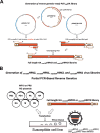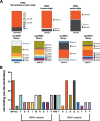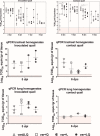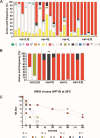Flexibility In Vitro of Amino Acid 226 in the Receptor-Binding Site of an H9 Subtype Influenza A Virus and Its Effect In Vivo on Virus Replication, Tropism, and Transmission
- PMID: 30567980
- PMCID: PMC6401463
- DOI: 10.1128/JVI.02011-18
Flexibility In Vitro of Amino Acid 226 in the Receptor-Binding Site of an H9 Subtype Influenza A Virus and Its Effect In Vivo on Virus Replication, Tropism, and Transmission
Abstract
Influenza A viruses (IAVs) remain a significant public health threat, causing more than 300,000 hospitalizations in the United States during the 2015-2016 season alone. While only a few IAVs of avian origin have been associated with human infections, the ability of these viruses to cause zoonotic infections further increases the public health risk of influenza. Of these, H9N2 viruses in Asia are of particular importance as they have contributed internal gene segments to other emerging zoonotic IAVs. Notably, recent H9N2 viruses have acquired molecular markers that allow for a transition from avian-like to human-like terminal sialic acid (SA) receptor recognition via a single amino acid change at position 226 (H3 numbering), from glutamine (Q226) to leucine (L226), within the hemagglutinin (HA) receptor-binding site (RBS). We sought to determine the plasticity of amino acid 226 and the biological effects of alternative amino acids on variant viruses. We created a library of viruses with the potential of having any of the 20 amino acids at position 226 on a prototypic H9 HA subtype IAV. We isolated H9 viruses that carried naturally occurring amino acids, variants found in other subtypes, and variants not found in any subtype at position 226. Fitness studies in quails revealed that some natural amino acids conferred an in vivo replication advantage. This study shows the flexibility of position 226 of the HA of H9 influenza viruses and the resulting effect of single amino acid changes on the phenotype of variants in vivo and in vitroIMPORTANCE A single amino acid change at position 226 in the hemagglutinin (HA) from glutamine (Q) to leucine (L) has been shown to play a key role in receptor specificity switching in various influenza virus HA subtypes, including H9. We tested the flexibility of amino acid usage and determined the effects of such changes. The results reveal that amino acids other than L226 and Q226 are well tolerated and that some amino acids allow for the recognition of both avian and human influenza virus receptors in the absence of other changes. Our results can inform better avian influenza virus surveillance efforts as well as contribute to rational vaccine design and improve structural molecular dynamics algorithms.
Keywords: H9 subtype; avian viruses; evolution; quail; receptor; sialic acid; transmission; zoonosis.
Copyright © 2019 Obadan et al.
Figures








References
Publication types
MeSH terms
Substances
Grants and funding
LinkOut - more resources
Full Text Sources

